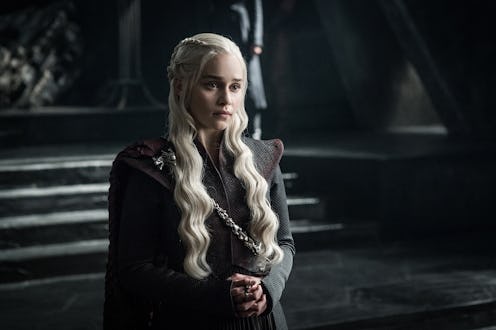Entertainment
How This One 'GoT' Season 7 Moment Became The Show's Most Feminist Scene

The world of Westeros has never been particularly kind to women, but in spite of all that, there are plenty of female characters in Game Of Thrones to root for. This year, however, it appears that things are changing, at least for the noblewomen of the realm — and "Stormborn," the second episode of this season of Game Of Thrones, contained a quietly powerful feminist moment that spells interesting things for the show’s future.
When thinking about Game of Thrones, most fans remember the big action-packed moments and violent twists, like the scene where Ned Stark lost his head in Season 1, the Red Wedding, or the Season 6 finale where Cersei Lannister blew up the Septa in a haze of green smoke. But most of the show consists of more quiet scenes, where characters meet and strategize with one another about what to do next. “Stormborn” contained one of these scenes, in which Daenerys Targaryen invites other leaders of Westeros — Ellaria Sand, Olenna Tyrell, and Yara Greyjoy — to discuss how best to take the throne from their shared enemy, Cersei Lannister.
Westerosi culture is predominantly patriarchal, meaning that the women who’ve held power in Game Of Thrones have, up until recently, done so entirely in relation to the men around them. Olenna, Ellaria, Yara, Daenerys, and even Cersei used to be second to their male spouses and family members — that is, until those men died, leaving them in charge by default. As a result, there’ve been plenty of moments where female characters have held their own against men, but much fewer where they’ve chosen to work together. If they’ve had support from other women along the way, it has typically been as superiors, not as any kind of equals. Daenerys may confide in Missandei, for example, but only one of them is truly in a position to challenge other leaders.
Which is why the scene in “Stormborn” felt so different; it marked the first time that a significant number of powerful women on Game of Thrones came together as allies, to defeat a common foe who also happens to be a woman. (There were men present too, of course, but they acted as advisors and servants, not as lords with power of their own).
Unfortunately, this is not just an unusual circumstance in Westeros. Boxed In, the annual survey of women in the television industry by the Center for the Study of Women in Television & Film, found that 79 percent of the programs they looked at in the 2015-2016 TV season had more male characters than female ones. Women also only accounted for 33 percent of all speaking characters on cable programs, and are less likely to be portrayed as leaders compared to male characters (only 3 percent compared to 8 percent for men). And that’s just in television; in the real world, women are given even fewer opportunities to hold leadership positions. The Pew Research Center found that American women are still underrepresented among political and business leaders in 2017, only making up 19.4 percent of Congress and 5.4 percent of Fortune 500 CEOs (remember, women are currently 51.4 percent of the U.S. population).
Of course, having a group of women together making political decisions together doesn’t always mean that they’ll make the right decisions, no more than having a group entirely made up of men does (although frequently in Game of Thrones, female characters are painted as the voices of reason when they’re the only ones in a room — think of how many times Catelyn Stark tried to stop Robb from doing dumb stuff). As much as Olenna’s insistence to Daenerys that she ignore the counsel of Tyrion Lannister and “be a dragon” made for an awe-inspiring soundbite, it might not be the best advice given that Tyrion is a much more shrewd strategist than Daenerys proven herself to be in the past.
But isn’t that what feminism is all about, at least in terms of TV representation? Presenting a sole female character as the best and the smartest in a room full of men can be empowering sometimes, but if that’s the only way women are depicted, it can also be dehumanizing — after all, we’re not all perfectly blonde dragon queens. Instead, television shows should strive to show us more women at the same time, of different ages and personalities and races (something even Game Of Thrones can stand to do better, as most of its women are white and of a similar temperament), who sometimes disagree with each other and make poor decisions.
Game Of Thrones isn’t a perfect beacon of feminism, obviously, but that it’s come so far in this particular way is very encouraging to those of us who’ve stuck with it all these years. Hopefully other shows will begin to follow its example in this instance and give women the space to be leaders together.